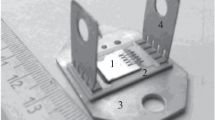Abstract
The task of developing a refined procedure for the determining thermal resistance coefficient of a power semiconductor device (PSD)–cooler contact allowing for roughness of contacting surfaces was set. For this purpose, mathematical modeling methods applying the theory of random functions and full-scale test methods of elements of semiconductor converters were used. Using the developed software and experimental dependences, the compressive forces and roughness of surfaces at which the maximum intensity of the contact heat transfer in power units with the evaporative-air cooling is attained are determined. It is shown that the number of contact spots and actual contact area increase with an increase in pressure thereby lowering the thermal resistance. The lower the surface roughness is, the lower the values of pressure are at which the maximum intensity of the contact heat exchange can be attained. Considerable lowering in the contact thermal resistance for each contact pair occurs for a definite pressure only, after which further increase in the load (larger than 20–30 mPa) does not yield the desirable effect of the contact thermal resistance and losses the sense thereof. The application of KPT-8 heat-conducting paste and K-1 adhesive lowers the contact by more than three times. The application of tin and iridium spacers for the PSD–cooler pair with nickel-plated surfaces has given no positive result. Based on the calculated and experimental data, the requirements for degree of treatment of contact surfaces using nickel coatings, heat-conducting pastes, and spacers that allow increasing in PSD cooling efficiency by 10–14% are refined.
Similar content being viewed by others
References
Kiselev, I.G., Isakeev, A.I., and Filatov, V.V., Effektivnye sposoby okhlazhdeniya silovykh poluprovodnikovykh priborov (Effective Way to Cool Powerful Semiconductor Devices), Leningrad: Energoizdat, 1982.
Buyanov, A.B., Stepanov, S.I., and Krylov, V.I., Research of contact heat resistance in SPP-cooler systems, Izv. Peterburg. Gos. Univ. Putei Soobscheniya, 2007, no. 4, pp. 107–114.
Kiselev, I.G. and Krylov, D.V., Mathematical simulation of contact heat exchange in semiconductor transducer plants for railway, Izv. Peterburg. Gos. Univ. Putei Soobscheniya, 2012, no. 1, pp. 66–71.
Author information
Authors and Affiliations
Corresponding author
Additional information
Original Russian Text © A.V. Grishchenko, I.G. Kiselev, A.S. Kornev, D.V. Krylov, 2016, published in Elektrotekhnika, 2016, No. 5, pp. 32–36.
About this article
Cite this article
Grishchenko, A.V., Kiselev, I.G., Kornev, A.S. et al. Increasing the cooling efficiency of power semiconductor devices. Russ. Electr. Engin. 87, 266–269 (2016). https://doi.org/10.3103/S1068371216050084
Received:
Published:
Issue Date:
DOI: https://doi.org/10.3103/S1068371216050084




